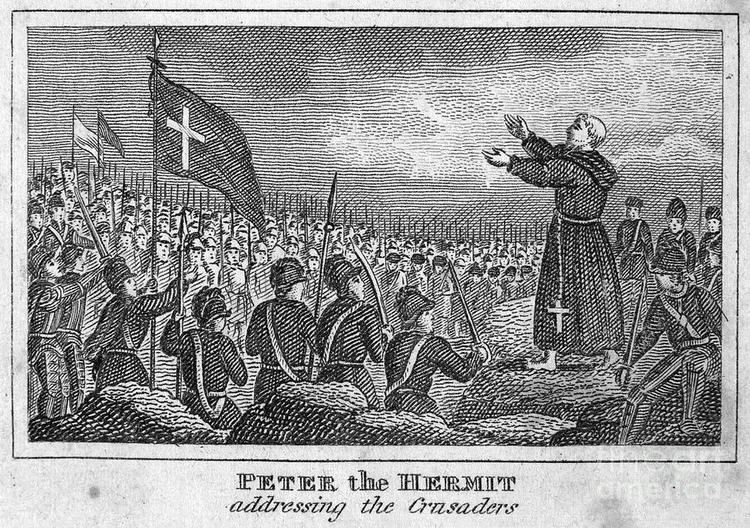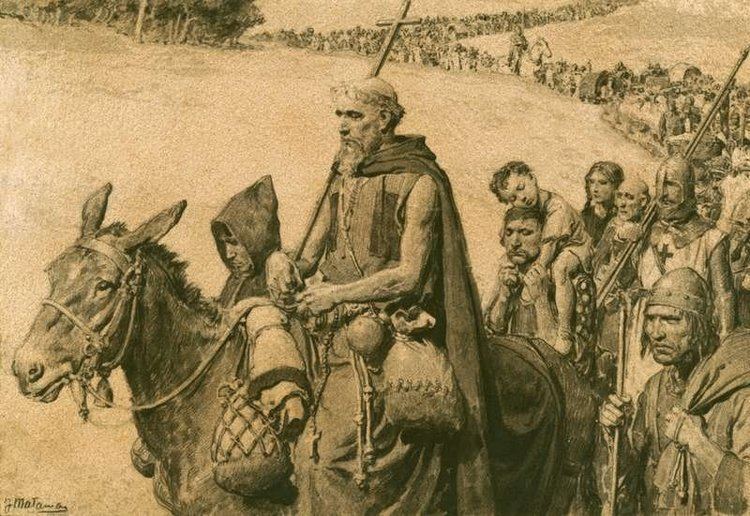Name Peter Hermit | ||
 | ||
Similar People Pope Urban II, Kilij Arslan I, Saladin | ||
Europe the first crusade ii peter the hermit extra history
Peter the Hermit (also known as Cucupeter, Little Peter or Peter of Amiens; c. 1050 – 8 July 1115) was a priest of Amiens and a key figure during the First Crusade.
Contents
- Europe the first crusade ii peter the hermit extra history
- Peter the hermit
- Family
- Before 1096
- Crusade to the Holy Land
- Role in Preaching First Crusade
- Later life
- Legend
- References

Peter the hermit
Family

His name in French is Pierre l'Ermite. The structure of this name in French unlike in English has led some francophone scholars to treat l'Ermite as a surname rather than a title.
Before 1096

According to Anna Comnena, he had attempted to go on a pilgrimage to Jerusalem before 1096, but was prevented by the Seljuk Turks from reaching his goal and was reportedly mistreated. However, doubts remain whether he ever made such a journey.

Sources differ as to whether he was present at Pope Urban II's famous Council of Clermont in 1095; but it is certain that he was one of the preachers of the crusade in France afterward, and his own experience may have helped to give fire to the Crusading cause. Tradition in Huy holds that he was there when the crusade was announced and he began his preaching at once. He soon leapt into fame as an emotional revivalist, and the vast majority of sources and historians agree that thousands of peasants eagerly took the cross at his bidding. However, Jonathan Riley-Smith has proposed that the People's Crusade also included well armed soldiers and nobles. This part of the crusade was also known as the crusade of the "paupers", a term which in the Middle Ages indicated a status as impoverished or mendicant wards of the Church. Peter organized and guided the paupers as a spiritually purified and holy group of pilgrims who would, supposedly, be protected by the Holy Ghost. A list of known participants in Peter's army can be found at Riley-Smith, et al.
Crusade to the Holy Land

In Germany in spring 1096 Peter had difficulty controlling his men, who went on rampages killing Jews.
Leading the first of the five sections of the People's Crusade to the destination of their pilgrimage, the Church of the Holy Sepulchre, he started (with 40,000 men and women) from Cologne in April, 1096, and arrived (with 30,000 men and women) at Constantinople at the end of July. The Eastern Roman Emperor Alexius I Comnenus was less than pleased with their arrival, for along with the head of the Eastern Orthodox Church, Patriarch Nicholas III of Constantinople, he was now required to provide for the care and sustenance of the vast host of paupers for the remainder of their journey.
Most of the paupers failed to make their way out of Roman Catholic jurisdiction. The majority were incapable of being provided for by the various lordships and dioceses along the way and either starved, returned home or were put into servitude, while a substantial number were captured and sold into slavery by the various Slavic robber barons in the Balkans, kindling the view of the Balkan Slavs as unredeemed robbers and villains. Peter joined the only other section which had succeeded in reaching Constantinople, that of Walter Sans Avoir, into a single group and encamped the still numerous pilgrims around Constantinople while he negotiated the shipping of the People's Crusade to the Holy Land. The Emperor meanwhile had failed to provide for the pilgrims adequately and the camp made itself a growing nuisance, as the increasingly hungry paupers turned to pilfering the imperial stores.
Alexius, worried at the growing disorder and fearful of his standing before the coming armed Crusader armies, quickly concluded negotiations and shipped them across the Bosporus to the Asiatic shore in the beginning of August, with promises of guards and passage through the Turkish lines. He warned the People's Crusade to await his orders, but in spite of his warnings, the paupers entered Turkish territory. The Turks began skirmishing with the largely unarmed host. Peter returned in desperation to Constantinople, seeking the Emperor's help.
In Peter's absence, the pilgrims were ambushed and cut to pieces in detail by the Turks, who were more disciplined, at the Battle of Civetot. Despite Peter's pronunciations of divine protection, the vast majority of the pilgrims were slaughtered by the swords and arrows of the Turks, or were enslaved. Left in Constantinople with the small number of surviving followers, during the winter of 1096–1097, with little hope of securing Byzantine support, the People's Crusade awaited the coming of the armed crusaders as their sole source of protection to complete the pilgrimage.
When the princes arrived, Peter joined their ranks as a member of council in May 1097, and with the little following which remained they marched together through Asia Minor to Jerusalem. While his "paupers" never regained the numbers previous to the Battle of Civetot, his ranks were increasingly replenished with disarmed, injured, or bankrupted crusaders. Nonetheless, aside from a few rousing speeches to motivate the Crusaders, he played a subordinate part in the remaining history of the First Crusade which at this point clearly settled on a military campaign as the means to secure the pilgrimage routes and holy sites in Palestine.
He appears, at the beginning of 1098, as attempting to escape from the privations of the siege of Antioch—showing himself, as Guibert of Nogent says, a "fallen star." However, Guibert and other sources go on to write that Peter was responsible for the speech before the half-starved and dead Crusaders which motivated their sally from the gates of Antioch and their subsequent crushing defeat of the overwhelmingly superior Muslim army besieging the city. Thus, having recovered his stature, in the middle of the year he was sent by the princes to invite Kerbogha to settle all differences by a duel which the Emir subsequently declined; and in 1099 he appears as treasurer of the alms at the siege of Arqa (March), and as leader of the supplicatory processions around the walls of Jerusalem before it fell and later within Jerusalem which preceded the Crusaders' miraculous victory at the Battle of Ascalon (August). At the end of the year he went to Latakia, and sailed thence for the West. From this time he disappears, but Albert of Aix records that he died in 1131, as prior of a church of the Holy Sepulchre which he had founded in France.
Role in Preaching First Crusade
Although later Catholic historians and many other scholars disagree, Roger of Wendover and Matthew Paris wrote that Peter the Hermit was the true author and originator of the First Crusade, a view also recounted in the anonymous Gesta Francorum – written c. 1100 – and by Albert of Aix in his Historia Hierosolymitanae Expeditionis, and also supported by some modern scholars.
Such historical sources recount that during an early visit to Jerusalem some time before 1096, Jesus appeared to Peter the Hermit in the Church of the Holy Sepulchre, and bade him preach the crusade. This story also appears in the pages of William of Tyre, which indicates that even a few generations after the crusade, the descendants of the crusaders already believed Peter was its originator. The origin of such a legend is a matter of some interest. Von Sybel, in his Geschichte des ersten Kreuzzuges, published in 1841, suggested that in the camp of the paupers (which existed side by side with that of the knights, and grew increasingly large as the crusade took a more and more heavy toll on the purses of the crusaders) some idolization of Peter the Hermit had already begun, parallel to the similar glorification of Godfrey by the Lorrainers.
Later life
There is very little concrete record for his life after returning to Europe and much of what we do know is speculation or legend. However, Albert of Aix records that he died in 1131, as prior of a church of the Holy Sepulchre which he had founded in France or Flanders.
It is generally quoted that he founded an Augustinian monastery in France named for the Church of the Holy Sepulchre. However, it was actually in Flanders at Neufmoustier near Huy, or Huy itself which may have been his home town. His tomb is in the Neufmoustier Abbey, so it is presumed that this was his Abbey but in another tradition the nearby Solières Abbey claims that it was his foundation.
His obituary is in the chronicle of Abbey Neufmoustier Huy. On its page entry of 8 July 1115 the chronicle says that this day saw "the death of Dom Pierre, of pious memory, venerable priest and hermit, who deserved to be appointed by the Lord to announce the first to the holy Cross" and the text continues with "after the conquest of the holy land, Pierre returned to his native country" and also that "he founded this church ... and chooses them a decent burial". This record further supports Neufmoustier's claim as his foundation.
Legend
Since his death various legends have sprung up around Peter. One legend has its roots in the writings of Jacques de Vitry, who found it convenient to convince people from the bishopric of Liège of the merits of participating in the Albigensian crusade by manipulating the story of Peter. Another legend is given in the 14th century by the French troubadour Jehan-de-Bouteiller, who sings the memory of "a dict Peter the Hermit deschendant a count of Clairmont by a Sieur d'Herrymont [who] married a Montagut". Peter the Hermit's parents would therefore be Renauld de Hérimont and Aleidis Montaigu (Aleidis is known in Huy as the "mother of Dom Pierre, with a home in Huy").
There is also a strong and old tradition that Peter the Hermit was the first to introduce the use of the Rosary. It follows that he began this tradition in about 1090. If this is the case and if he had also been on a previous pilgrimage to Jerusalem, it is possible that he derived this practice from similar Islamic practices.
